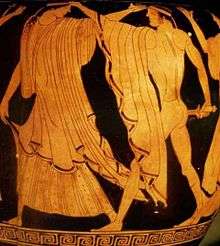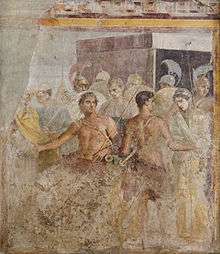Agamemnon
In Greek mythology, Agamemnon /æɡəˈmɛmnɒn/ (Greek: Ἀγαμέμνων, Ἀgamémnōn) was a king of Mycenae, the son of King Atreus and Queen Aerope of Mycenae, the brother of Menelaus, the husband of Clytemnestra and the father of Iphigenia, Electra or Laodike (Λαοδίκη), Orestes and Chrysothemis.[1] Legends make him the king of Mycenae or Argos, thought to be different names for the same area.[2] When Menelaus's wife, Helen, was taken to Troy by Paris, Agamemnon commanded the united Greek armed forces in the ensuing Trojan War.

Upon Agamemnon's return from Troy, he was killed (according to the oldest surviving account, Odyssey 11.409–11) by Aegisthus, the lover of his wife Clytemnestra. In old versions of the story, the scene of the murder, when it is specified, is usually the house of Aegisthus, who has not taken up residence in Agamemnon's palace, and it involves an ambush and the deaths of Agamemnon's followers as well (or it seems to be an ancestral home of both Agamemnon and Aegisthus since Agamemnon's wife is stated to be there as well and Agamemnon was said to have wept and kissed the land of his birth).[3] In some later versions Clytemnestra herself does the killing, or she and Aegisthus act together, killing Agamemnon in his own home.
Etymology
His name in Greek, Ἀγαμέμνων, means "very steadfast", "unbowed". The word comes from *Ἀγαμέδμων from ἄγαν, "very much" and μέδομαι, "think on".[4]
Early life
Agamemnon's father, Atreus, murdered the sons of his twin brother Thyestes and fed them to Thyestes after discovering Thyestes' adultery with his wife Aerope. Thyestes fathered Aegisthus with his own daughter, Pelopia, and this son vowed gruesome revenge on Atreus' children. Aegisthus murdered Atreus, restored Thyestes to the throne and took possession of the throne of Mycenae and jointly ruled with his father. During this period, Agamemnon and his brother, Menelaus, took refuge with Tyndareus, King of Sparta. There they respectively married Tyndareus' daughters Clytemnestra and Helen. Agamemnon and Clytemnestra had four children: one son, Orestes, and three daughters, Iphigenia, Electra and Chrysothemis. Menelaus succeeded Tyndareus in Sparta, while Agamemnon, with his brother's assistance, drove out Aegisthus and Thyestes to recover his father's kingdom. He extended his dominion by conquest and became the most powerful prince in Greece.[5]
Agamemnon's family history had been tarnished by murder, incest, and treachery, consequences of the heinous crime perpetrated by his ancestor, Tantalus, and then of a curse placed upon Pelops, son of Tantalus, by Myrtilus, whom he had murdered. Thus misfortune hounded successive generations of the House of Atreus, until atoned by Orestes in a court of justice held jointly by humans and gods.
Trojan War
Agamemnon gathered the reluctant Greek forces to sail for Troy. Preparing to depart from Aulis, a port in Boeotia, Agamemnon's army incurred the wrath of the goddess Artemis. There are several reasons throughout myth for such wrath: in Aeschylus' play Agamemnon, Artemis is angry for the young men who will die at Troy, whereas in Sophocles' Electra, Agamemnon has slain an animal sacred to Artemis, and subsequently boasted that he was Artemis' equal in hunting. Misfortunes, including a plague and a lack of wind, prevented the army from sailing. Finally, the prophet Calchas announced that the wrath of the goddess could only be propitiated by the sacrifice of Agamemnon's daughter Iphigenia.
Classical dramatizations differ on how willing either father or daughter was to this fate; some include such trickery as claiming she was to be married to Achilles, but Agamemnon did eventually sacrifice Iphigenia. Her death appeased Artemis, and the Greek army set out for Troy. Several alternatives to the human sacrifice have been presented in Greek mythology. Other sources, such as Iphigenia at Aulis, say that Agamemnon was prepared to kill his daughter, but that Artemis accepted a deer in her place, and whisked her away to Tauris in the Crimean Peninsula. Hesiod said she became the goddess Hecate.
Agamemnon was the commander-in-chief of the Greeks during the Trojan War. During the fighting, Agamemnon killed Antiphus and fifteen other Trojan soldiers, according to one source.[6] But in the "Iliad" itself, he's shown to slaughter hundreds more in Book 11 during his aristea loosely translated to "day of glory" which is the most similar to Achilles' aristea in Book 21 (they both are compared to lions and destructive fires in battle, their hands are described as "splattered with gore" and "invincible," the Trojans flee to the walls, they both are appealed to by one of their victims, they are both avoided by Hector, they both get wounded in the arm or hand, and they both kill the one who wounded them). Even before his aristea, Agamemnon was considered to be one of the three best warriors on the Greek side as proven when Hector challenges any champion of the Greek side to fight him in Book 7, and Agamemnon (along with Diomedes and Big Aias) is one of the three most wished for to face him out of the nine strongest Greek warriors who volunteered. And after they reconciled, even Achilles admits in Book 23 that Agamemnon is "the best in strength and in throwing the spear." That claim is further proven by the fact that Agamemnon was the only major warrior on either side never to need the gods' direct intervention to increase his strength or give him any unfair advantages in battle and yet he still caused incredible destruction almost on the scale of Achilles.
The Iliad tells the story about the quarrel between Agamemnon and Achilles in the final year of the war. Following one of the Achaean Army's raids, Chryseis, daughter of Chryses, one of Apollo's priests, was taken as a war prize by Agamemnon. Chryses pleaded with Agamemnon to free his daughter but was met with little success. Chryses then prayed to Apollo for the safe return of his daughter, which Apollo responded to by unleashing a plague over the Achaean Army. After learning from the Prophet Calchas that the plague could be dispelled by returning Chryseis to her father, Agamemnon reluctantly agreed (but first berated Calchas for previously forcing Agamemnon to sacrifice his daughter Iphigenia) and released his prize. However, as compensation for his lost prize, Agamemnon demanded a new prize. He stole an attractive slave called Briseis, one of the spoils of war, from Achilles.[7]
In response to being deprived of Briseis, Achilles withdrew from battle and put the Greek armies at risk of losing the war. Agamemnon, having realized Achilles's importance in winning the war against the Trojan Army, sent ambassadors begging for Achilles to return, offering him riches and the hand of his daughter in marriage, but Achilles refused, only being spurred back into action when his closest friend, Patroclus, was killed in battle.
Although not the equal of Achilles in bravery, Agamemnon was a representative of "kingly authority". As commander-in-chief, he summoned the princes to the council and led the army in battle. His chief fault was his overwhelming haughtiness; an over-exalted opinion of his position that led him to insult Chryses and Achilles, thereby bringing great disaster upon the Greeks.[5]
After the capture of Troy, Cassandra, the doomed prophetess and daughter of Priam, fell to Agamemnon's lot in the distribution of the prizes of war.[5]
Return to Greece

After a stormy voyage, Agamemnon and Cassandra landed in Argolis, or, in another version, were blown off course and landed in Aegisthus' country. Clytemnestra, Agamemnon's wife, had taken Aegisthus, son of Thyestes, as a lover. When Agamemnon came home he was slain by Aegisthus (in the oldest versions of the story)[8] or by Clytemnestra. According to the accounts given by Pindar and the tragedians, Agamemnon was slain in a bath by his wife alone, after being ensnared by a blanket or a net thrown over him to prevent resistance.[9] Clytemnestra also killed Cassandra. Her jealousy of Cassandra, and her wrath at the sacrifice of Iphigenia and at Agamemnon's having gone to war over Helen of Troy, are said to have been the motives for her crime. [5]
Aegisthus and Clytemnestra then ruled Agamemnon's kingdom for a time, Aegisthus claiming his right of revenge for Atreus's crimes against Thyestes (Thyestes then crying out "So perish all the race of Pleisthenes!",[10] thus explaining Aegisthus' action as justified by his father's curse). Agamemnon's son Orestes later avenged his father's murder, with the help or encouragement of his sister Electra, by murdering Aegisthus and Clytemnestra (his own mother), thereby inciting the wrath of the Erinyes (English: the Furies), winged goddesses who tracked down wrongdoers with their hounds' noses and drove them to insanity.
Other stories
Athenaeus tells a tale of how Agamemnon mourned the loss of his friend or lover Argynnus, when he drowned in the Cephisus river.[11] He buried him, honored with a tomb and a shrine to Aphrodite Argynnis.[12] This episode is also found in Clement of Alexandria,[13] in Stephen of Byzantium (Kopai and Argunnos), and in Propertius, III with minor variations.[14]
The fortunes of Agamemnon have formed the subject of numerous tragedies, ancient and modern, the most famous being the Oresteia of Aeschylus. In the legends of the Peloponnesus, Agamemnon was regarded as the highest type of a powerful monarch, and in Sparta he was worshipped under the title of Zeus Agamemnon. His tomb was pointed out among the ruins of Mycenae and at Amyclae.
Another account makes him the son of Pleisthenes (the son or father of Atreus), who is said to have been Aerope's first husband.
In works of art, there is considerable resemblance between the representations of Zeus, king of the gods, and Agamemnon, king of men. He is generally depicted with a sceptre and diadem, conventional attributes of kings.
Agamemnon's mare was named Aetha. She was also one of two horses driven by Menelaus at the funeral games of Patroclus.[15][16]
In Homer's Odyssey Agamemnon made an appearance in the kingdom of Hades after his death. There, the former king met Odysseus and explained just how he was murdered before he offered Odysseus a warning about the dangers of trusting a woman.[17]
See also
- HMS Agamemnon
- Mask of Agamemnon
- National Archaeological Museum of Athens
References
- Homer, Iliad 9:145.
- Leeming, David (2005). Argos. Oxford Companion to World Mythology. Oxford: Oxford University Press. ISBN 9780199916481.
- Aeschylus (1986), Choephori; introduction by A. F. Garvie, Oxford University Press, p. x
- R. S. P. Beekes, Etymological Dictionary of Greek, Brill, 2009, p. 8.
- Chisholm 1911.
- Hyginus, Fabulae 114.
- Homer, Iliad Translated by Robert Fagles, Penguin Classics, 1998
- Homer, Odyssey 3:266
- Aeschylus, Agamemnon, 1389
- Aeschylus, Agamemnon, 1602
- Lewis, Charlton T.; Short, Charles. "Argynnus". A Latin Dictionary. Perseus Project. Retrieved 16 September 2011.
- The Deipnosophists of Athenaeus of Naucratis, Book XIII Concerning Women, 80D (p. 603)
- Clement of Alexandria, Protrepticus II.38.2
- Butler, Harold Edgeworth & Barber, Eric Arthur, eds. (1933) The Elegies of Propertius. Oxford: Clarendon Press; p. 277
- Pausanias. Description of Greece; 5.8.3
- Plutarch, Amores, 21
- Homer, Odyssey 11: 485–486
Sources
Primary sources
Secondary sources

